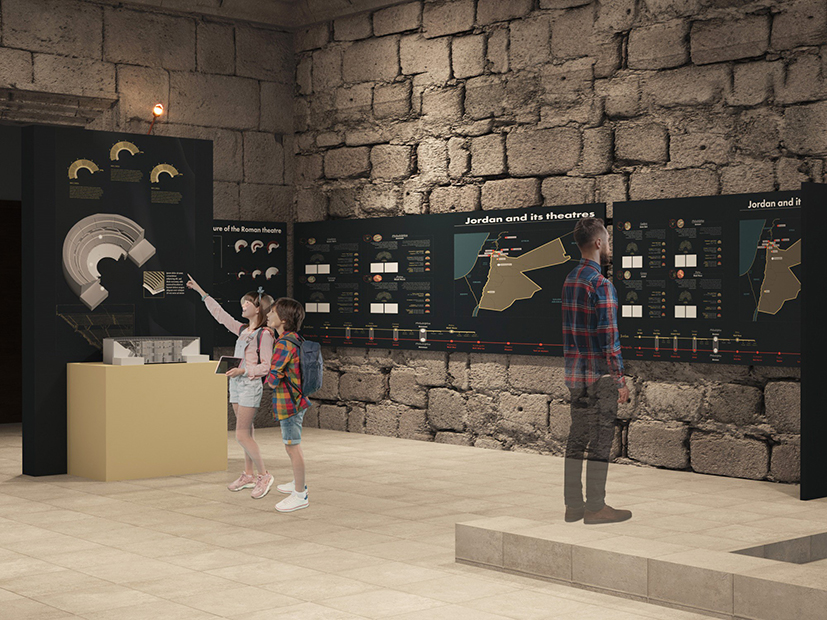
The Tale of the Roman Theater of Philadelphia, Amman. Representative and experiential methodology of the theatrical space
Abstract
The project aims to present the 3D reconstruction of the Roman Theater of Amman, the ancient Philadelphia of the Palestinian Decapolis, through rigorous representative models. The outcomes will be part of a future exhibition providing site-specific installations and user experience artifacts based on digital interaction and tactile models. The paper illustrates the multidisciplinary approach associated with using 3D virtual reconstruction and game engine tools to reflect on the practice of representing ancient monuments and digital museology. Travelers of the 18th and 19th centuries drafted the fascination of discovery as an experience in their notebooks. At the same time, their written records could address contemporary visitors to an extensive cultural knowledge of places and buildings, the historia of Philadelphia. Investigations are shifting scientific models towards a dynamic cultural experience representative of cultural heritage, including intangible heritage, stories, and new technological paradigms, increasingly rapidly making it possible to duplicate art and heritage. This shift is pinpointing the role of representation for cultural studies and humanities, experimenting with practices and tools to drill methodologies, and producing models for interaction design, socialization, gaming, and museum experience.
DOI: https://doi.org/10.20365/disegnarecon.31.2023.15
Keywords
Full Text:
PDFReferences
Al-Fakharani, F. (1975). Das Theater von Amman, Jordanien. Archäologischer Anzeiger, 3, 377-403.
Almagro, A. (1983). The Survey of The Roman Monuments of Amman by the Italian Mission. Annual of the Department of Antiquities of Jordan, 27, 607-639.
Almagro, A., Almagro-Vidal, A. (2007). Traditional drawings versus new representation techniques. XXI International CIPA Symposium, 01-06 October 2007, Athens, Greece. Atene: CIPA.
Amoruso G., Carioni C. (2023). Roman Theatre Experience the Making of Digital Reconstruction. Trizio I., Demetrescu E., Ferdani D. (eds) Digital Restoration and Virtual Reconstructions. Case Studies and Compared Experiences for Cultural Heritage (pp. 275-295). Cham: Springer Nature.
Botarelli, L. (2015). The Theater. Anastasio S., Botarelli L. (eds) The 1927-1938 Italian Archaeological Expedition to Transjordan in Renato Bartoccini’s Archive (pp. 163-175). Oxford: Archaeopress Archaeology.
Butler, H.C. (1907). Ancient Architecture in Syria. Leiden: Brill.
Chancey, M.A., & Porter, A.L. (2001). The Archaeology of Roman Palestine. The University of Chicago Press Journals, 64(4), 164–203.
Conder, C.R. (1889). The Survey of Eastern Palestine, I. London: Committee of the Palestine Exploration Fund.
Engeström J. (2005). Why some social network services work and others don’t — Or: the case for object-centered sociality. Retrieved November 29, 2023, fromhttp://www.zengestrom.com/blog/2005/04/why-some-social-network-services-work-and-others-dont-or-the-case-for-object-centered-sociality.html.
Ferdani, D., & Demetrescu, E. (2021). ATON: An open-source framework for creating immersive, collaborative and liquid web-apps for cultural heritage. Applied Sciences, 11(22), 11062.
Jones, M.W. (2000). Principles of Roman Architecture. New Haven: Yale University Press.
Laborde, L.E.S.J. (1837). Voyage en Orient. Parigi: Giard.
Refbacks
- There are currently no refbacks.
Copyright (c) 2023 Giuseppe Amoruso
DISEGNARECON
ISSN 1828 5961
Registration at L'Aquila Law Court no 3/15 on 29th June, 2015.
Indexed in SCOPUS. Diamond Open Access. All papers are subjected to double blind peer review process by qualified reviewers.
Journal founded by Roberto Mingucci
